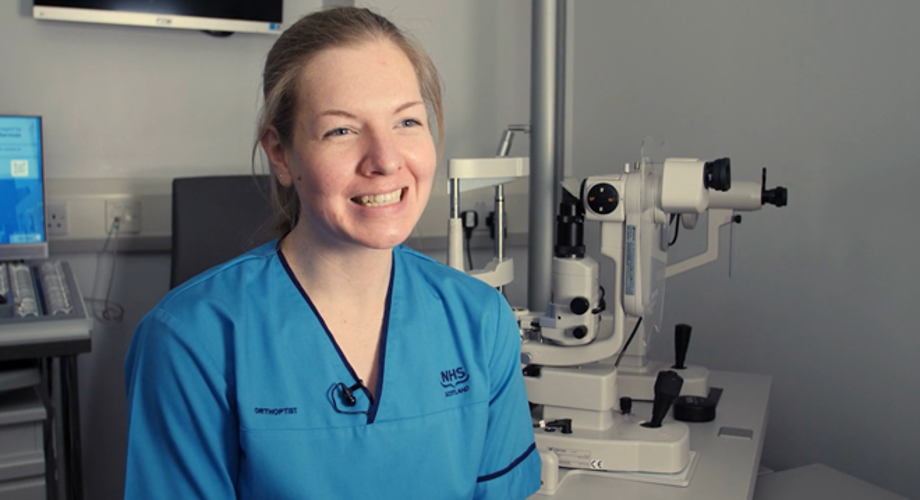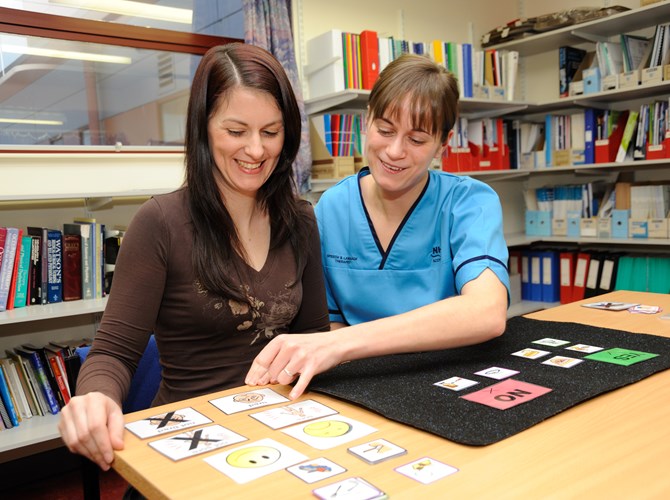09 October 2023
•8 min read

Who is Catherine?
Catherine is a specialist orthoptist at NHS Fife and has been practising for 10 years. She is also a lecturer and researcher in vision sciences at Glasgow Caledonian University.
Orthoptics wasn't Catherine's original plan. She wanted to have a career in medicine. After researching allied health professions, she came across orthoptics. During some work experience in a local orthoptic practice, she knew it was the career choice for her.
What does being an orthoptist involve?
Catherine thinks of orthoptics as being physiotherapy for the eyes. They are often the first healthcare professionals who will investigate and diagnose eye symptoms. Orthoptists can treat:
- squints
- lazy eyes
- double vision
Each day is different for Catherine in the clinic. She can see patients of all ages. She gets to make all the decisions for care and treatment of patients. When a team approach is required, she will collaborate with other healthcare professionals.
Catherine enjoys the continued learning that orthoptics offers. She might come across a new condition or a piece of research for treatment, and it's her responsibility to keep her practice up to date.
Skills needed by an orthoptist are:
- good communication
- adaptability
- problem-solving
- autonomous working
The variety of the work and the patients Catherine works with is what makes being an orthoptist a rewarding and interesting career.
How to watch our 360 videos
To navigate the 360 videos on this page, follow these instructions:
- If you are using a mouse, hold the left or right button to move the cursor around the screen. Move the cursor to the left to turn left, and to the right to turn right, and so on.
- If you are using a laptop trackpad, click and hold anywhere on the trackpad, then use your finger to move the cursor around the screen. Move your finger to the left to turn left, and to the right to turn right, and so on.
- If you are using a mobile, press and hold the screen while moving your finger. Move your finger to the left to turn left, and to the right to turn right, and so on.
To get the full AHP VR experience, download our immersive video files to your headset.
Scene one video: testing eye muscles
Catherine starts by asking the patient to follow the torch as she moves it into the nine diagnostic positions of gaze. This allows the orthoptist to test the functions of the six extraocular muscles.
This patient has double vision caused by a weakness of both lateral rectus muscles. The function of these muscles is to pull the eyes outwards.
Catherine checks how each eye moves independently and as a pair. This gives her information on the cause of the double vision. It can also help to determine the next step for the patient’s diagnosis and management. This can include referrals for:
- brain scanning
- blood tests
- muscle biopsies
Scene two video: plotting eye movements
As an orthoptist, Catherine is a specialist in assessing eye movements. Catherine has set up the patient on a Lees screen. A Lees screen will record a diagram of the patient's eye movements. Catherine takes the patient through the following steps:
- She asks the patient to look at the target screen with one eye. The other eye sees the reflection in a mirror on the second screen.
- The patient uses the pointer to show where their eyes are sitting.
- This test can be repeated and compared at each visit to track recovery or deterioration.
A Lees test aids with the communication of the patient's eye movement. It can highlight difficulties and show where problems lie.
Scene three video: measurement of Strabismus
Strabismus is a misalignment of the eyes. When the eyes are not aligned, the orthoptist is able to measure the size of the squint using prisms. Catherine asks the patient to look at a target straight ahead. By using a prism bar, she can neutralise the movement seen. This measurement works out how much eye muscle surgery is required. It can also measure how much prism the patient needs to join their double vision.
You can become an orthoptist like Catherine
Orthoptists investigate and diagnose visual impairments related to the eyes. They use their specialist skills and training to offer treatments and exercises to help patients. Orthoptics is a rewarding career and good to consider if you are:
- observational
- good at problem-solving
- enjoy the practical side of science and anatomy

Start your journey in healthcare
Explore more professions with 360 videos and interviews that introduce other allied health professions (AHPs).